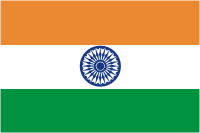
 The ceremony was conducted in two parts - the first of which was short and sweet on Saturday evening. Upon arriving by bus, the bride's family greeted us at the door (actually, the parents of the bride came on the bus to bless us and adorn us with the first of many tikkas) and feed us after our long journey of heavy monsoon rains accented by traditional Indian songs. The accompanying music was fantastic - an interesting double percussion "tabla" is played with a a pair of sticks, and a variation of a clarinet - a long, slender, reeded woodwind.
The ceremony was conducted in two parts - the first of which was short and sweet on Saturday evening. Upon arriving by bus, the bride's family greeted us at the door (actually, the parents of the bride came on the bus to bless us and adorn us with the first of many tikkas) and feed us after our long journey of heavy monsoon rains accented by traditional Indian songs. The accompanying music was fantastic - an interesting double percussion "tabla" is played with a a pair of sticks, and a variation of a clarinet - a long, slender, reeded woodwind. The Saturday evening ceremony was capped by a traditional coming together of the two families in which the bride and groom faced each other while surrounded by their families. They then proceeded to beckon the other to step forward, attempting to get the other one to move first in an interesting game of chicken. I have attempted to capture some of this on the video below. This was of course followed by a huge south Indian meal consisting of dal (spiced lentils), chutneys (mango, coconut), idli (rice flour cakes), vada (deep fried donut-shaped rings made from rice flour), and samba (sauce-like tomato and onion mixture).
The Saturday evening ceremony was capped by a traditional coming together of the two families in which the bride and groom faced each other while surrounded by their families. They then proceeded to beckon the other to step forward, attempting to get the other one to move first in an interesting game of chicken. I have attempted to capture some of this on the video below. This was of course followed by a huge south Indian meal consisting of dal (spiced lentils), chutneys (mango, coconut), idli (rice flour cakes), vada (deep fried donut-shaped rings made from rice flour), and samba (sauce-like tomato and onion mixture).On Sunday the real ceremony began. The puja (prayer ceremonies) began in earnest in the afternoon. Offerings and blessings were made in what seemed like thousands of different ways - each with the choreographed assistance of elders and brahmen as well as family who provided ample supply of various leafs, seeds, powders, pastes, flowers, incense, fruit, nuts, ornaments, or any other natural object necessary for puja. There were small fires for promises made to the fire god that was managed with a large beetle leaf. It was really something to see.
Afterwards there was a large meal and then - more puja. And then - more puja. Did I mention - more puja. At about 6AM the puja was completed (I had to work this morning at 8:30) and we boarded the bus back to Hyderabad. The room was strewn with sleeping bodies from a long night's worth of puja. But it was worth every minute.



2 comments:
Hey Mr. Kaplo-
India looks really interesting. I love the clothing! Crystal, Caitlyn, Hilary and I introduced ourselves to Dr. Sharma today. Hes so quite! They have Physics with him, I'm taking anatomy. :/ We miss you and can't wait to see you! I miss seeing you at the grocery store! lol
-Emma Rafferty
Mr. Kaplo,
Whats up, looks like it has been good in India for you so far. I am having a very good time at WPI. Send me an e-mail if you have free time.
Post a Comment